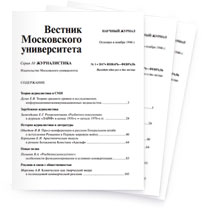Technology of Creating a Negative Image of Donald Trump in The New Yorker Magazine in 2019
Download paperDoctor of Philology, Professor, Head of the Chair of Media Linguistics, Faculty of Journalism, Lomonosov Moscow State University, Moscow, Russia
e-mail: pbalditsyn@gmail.comSection: Essay
This paper contains an analysis of stories, articles, letters, photographs and pictures of the American magazine The New Yorker for 2019 which represent a targeted campaign to discredit Donald Trump. It should be borne in mind that today the magazine is published in two main formats: as a traditional paper weekly and as an online publication Daily. In the printed version of the magazine, the presence of Trump‘s criticism was indispensable but not significant: one or two articles, several cartoons, only 1–2% of the text. Here The New Yorker was true to its intellectual and aesthetic traditions. In the online version, however, there were a number of articles and reports against the current president of the United States (up to 10 per day, nearly two-thirds of the columns Reporting and News & Politics). The online version was clearly serving the purposes of political struggle and propaganda. The particularity of this campaign was that its materials were in the tradition of quality journalism, they included a lot of reliable facts, quotes and opinions, but were presented in a completely one-sided perspective and created a negative “framing” effect, which was far from objective. For this, various media and linguistic means were used: caustic cartoons, sometimes on covers, photographs that distorted the appearance of the object and caused laughter or disgust, in the texts – the selection of negative vocabulary, quotes, idioms, comparisons and metaphors, repetition of stamps and clichés of a certain connotation (“liar”, “racist”, “sexist”, “fascist” and the like), the use of sacred concepts and names from national history, on the one hand, and the mentions of odious political figures of our days, on the other, only to emphasize Trump’s negative personal qualities and his inability to fulfill the position. In addition, satirical miniatures by Andy Borowitz regularly appeared in Daily, where grotesque, hyperbole and outright fantasy were generously used. In general, all these materials of the New Yorker magazine against Trump were indicative of the functions of a satirical pamphlet, whose aims are to expose, unmask and ridicule, to overthrow social evil.
DOI: 10.30547/vestnik.journ.1.2021.175191References:
Balditsyn P. V. (2004) Politicheskiy pamflet: teoriya i praktika zhanra [Political Pamphlet: Theory and Practice of the Genre]. In P. V. Balditsyn (ed.) Tvorchestvo Marka Tvena i natsional’nyy kharakter amerikanskoy literatury [Mark Twain’s Works and the National Character of American Literature]. Moscow: «VK» Publ. Pp. 203–220. (In Russian)
Balditsyn P. V. (2018) «N’yu-Yorker» – publitsisticheskiy i literaturno-khudozhestvennyy ezhenedel’nik dlya intellektualov [The New Yorker as a Journalistic and Literary Weekly for Intellectuals]. In Zarubezhnye ezhenedel’niki: istoriya i sovremennost’ [Foreign Weeklies: History and Modernity]. Moscow: Moscow State Univ. Faculty of Journalism Publ. Pp. 274–318. (In Russian)
Bubnova N. I. (2017) Zakusiv udila: protivostoyanie Donal’da Trampa i amerikanskikh SMI [Taking the Bit in Teeth: the Confrontation of Donald Trump and American Media]. Rossiya i sovremennyy mir 4 (97): 222–236. (In Russian)
Dobrosklonskaya T. G. (2008) Medialingvistika: sistemnyy podkhod k izucheniyu yazyka SMI (sovremennaya angliyskaya mediarech’) [Media Linguistics: a Systemic Approach to Studying Media Language (Modern English Media Speech]. Moscow: Flinta: Nauka Publ. (In Russian)
Dobrosklonskaya T. G. (2009) Lingvisticheskie sposoby vyrazheniya ideologicheskoy modal’nosti v mediatekstakh [Linguistic Ways to Express Ideological Modality in Media Texts]. Vestn. Mosk. un-ta. Ser. 19: Lingvistika i mezhkul’turnaya kommunikatsiya 2: 85–94. (In Russian)
Entman R. M. (1993) Framing: Toward Clarification of a Fractured Paradigm. Journal of Communication Autumn 43 (4): 51–58. DOI: https://doi.org/10.1111/j.1460-2466.1993.tb01304.x
Goffman E. (1974) Frame Analysis: an Essay on the Organization of Experience. Cambridge: Harvard University Press.
Goffman E. (2004) Analiz freymov: esse ob organizatsii povsednevnogo opyta [Frame Analysis: an Essay on the Organization of Experience]. Moscow: Institute of sociology (RAS) Publ. (In Russian)
Kuypers J. A. (2009) Framing Analysis. In J. A. Kuypers (ed.) Rhetorical Criticism: Perspectives in Action. Lanham; New York: Lexington Books. P. 181–203.
Kuypers J. A. (2010) Framing Analysis from a Rhetorical Perspective. In P. D’Angelo, J. A. Kuypers (eds.) Doing News Framing Analysis. New York; London: Routledge. Pp. 286–311.
Rourke C. (1994) Amerikanskiy yumor. Issledovanie natsional’nogo kharaktera [American Humor. A Study of the National Character]. Krasnodar: Kuban State Univ. Publ. (In Russian)
Yagoda B. (2000) About Town: The New Yorker and the World It Made. New York: Da Capo Press.






